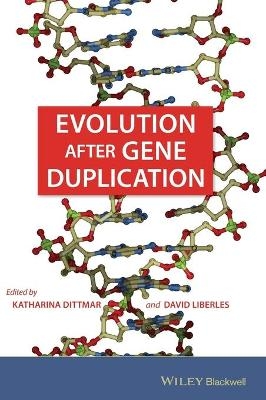
Evolution after Gene Duplication
Wiley-Blackwell (Verlag)
978-0-470-59382-0 (ISBN)
- Lieferbar (Termin unbekannt)
- Versandkostenfrei
- Auch auf Rechnung
- Artikel merken
Gene duplication has long been believed to have played a major role in the rise of biological novelty through evolution of new function and gene expression patterns. The first book to examine gene duplication across all levels of biological organization, Evolution after Gene Duplication presents a comprehensive picture of the mechanistic process by which gene duplication may have played a role in generating biodiversity. Key Features:
Explores comparative genomics, genome evolution studies and analysis of multi-gene families such as Hox, globins, olfactory receptors and MHC (immune system)
A complete post-genome treatment of the topic originally covered by Ohno's 1970 classic, this volume extends coverage to include the fate of associated regulatory pathways
Taps the significant increase in multi-gene family data that has resulted from comparative genomics
Comprehensive coverage that includes opposing theoretical viewpoints, comparative genomics data, theoretical and empirical evidence and the role of bioinformatics in the study of gene duplication
This up-to-date overview of theory and mathematical models along with practical examples is suitable for scientists across various levels of biology as well as instructors and graduate students.
Katharina Dittmar de la Cruz holds both a Ph.D. in Molecular Parisitology and Entomology and a doctorate in Veterinary Medicine, both from the University of Leipzig, Germany. An expert in phylogenetics, molecular evolution, and bioinformatics, she has recently turned her attention toward examining the implications of evolutionary forces on drug design. Dr. Dittmar is an Assistant Professor at the SUNY University at Buffalo. David Liberles earned his Ph.D. in Chemistry at the California Institute of Technology working on the biochemsitry of nucleic acids. Subsequently, he has developed significant expertise in bioinformatics, computational biology and functional genomics. His broad experience includes a professorship at the Stockholm Bioinformatics Center and consultancies with Novo Nordisk and other private research and diagnostic companies. Currently he is Vice-Director of the University of Wyoming Bioinformatics Center and Assistant Professor of Molecular Biology.
Contributors vii
Preface xi
1 Understanding Gene Duplication Through Biochemistry and Population Genetics 1
David A. Liberles, Grigory Kolesov, and Katharina Dittmar
2 Functional Divergence of Duplicated Genes 23
Takashi Makino, David G. Knowles, and Aoife McLysaght
3 Duplicate Retention After Small- and Large-Scale Duplications 31
Steven Maere and Yves Van de Peer
4 Gene Dosage and Duplication 57
Fyodor A. Kondrashov
5 Myths and Realities of Gene Duplication 77
Austin L. Hughes and Robert Friedman
6 Evolution After and Before Gene Duplication? 105
Tobias Sikosek and Erich Bornberg-Bauer
7 Protein Products of Tandem Gene Duplication: A Structural View 133
William R. Taylor and Michael I. Sadowski
8 Statistical Methods for Detecting Functional Divergence of Gene Families 163
Xun Gu
9 Mapping Gene Gains and Losses Among Metazoan Full Genomes Using an Integrated Phylogenetic Framework 173
Athanasia C. Tzika, Rapha¨el Helaers, and Michel C. Milinkovitch
10 Reconciling Phylogenetic Trees 185
Oliver Eulenstein, Snehalata Huzurbazar, and David A. Liberles
11 On the Energy and Material Cost of Gene Duplication 207
Andreas Wagner
12 Fate of a Duplicate in a Network Context 215
Orkun S. Soyer
13 Evolutionary and Functional Aspects of Genetic Redundancy 229
Ran Kafri and Tzachi Pilpel
14 Phylogenomic Approach to the Evolutionary Dynamics of Gene Duplication in Birds 253
Chris L. Organ, Matthew D. Rasmussen, Maude W. Baldwin, Manolis Kellis, and Scott V. Edwards
15 Gene and Genome Duplications in Plants 269
Pamela S. Soltis, J. Gordon Burleigh, Andre S. Chanderbali, Mi-Jeong Yoo, and Douglas E. Soltis
16 Whole Genome Duplications and the Radiation of Vertebrates 299
Shigehiro Kuraku and Axel Meyer
Index 313
| Zusatzinfo | Drawings: 0 B&W, 0 Color; Tables: 0 B&W, 0 Color; Graphs: 0 B&W, 0 Color |
|---|---|
| Verlagsort | Hoboken |
| Sprache | englisch |
| Maße | 185 x 262 mm |
| Gewicht | 785 g |
| Themenwelt | Informatik ► Weitere Themen ► Bioinformatik |
| Naturwissenschaften ► Biologie ► Genetik / Molekularbiologie | |
| ISBN-10 | 0-470-59382-2 / 0470593822 |
| ISBN-13 | 978-0-470-59382-0 / 9780470593820 |
| Zustand | Neuware |
| Haben Sie eine Frage zum Produkt? |
aus dem Bereich


